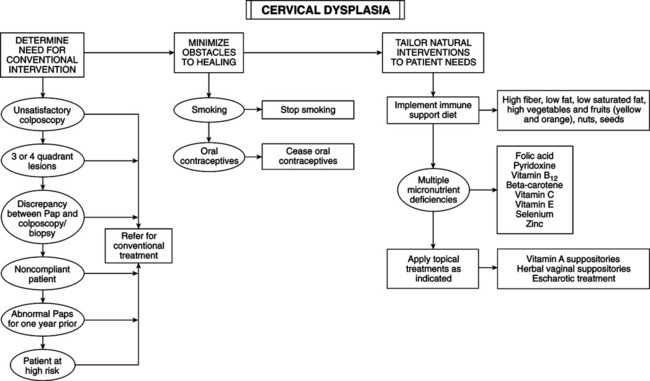• Abnormal Pap smears (atypical cells of undetermined significance; low-grade squamous intraepithelial lesions; high-grade squamous intraepithelial lesions) • Colposcopy, endocervical curettage, cervical biopsies: one of following three options for managing ASC-US is acceptable: 2. Repeat Pap twice at 4- to 6-month intervals with referral to colposcopy if repeat Pap is the same or worse. 3. Human papilloma virus (HPV) testing with referral to colposcopy for high-risk subtypes. • Management guidelines for ASC-H, LSIL, and HSIL are as follows: ASC-US: atypical cells of undetermined significance ASC-H: atypical cells, cannot rule out high-grade lesions CIN I: condyloma (warty tissue) or mild cervical dysplasia CIN II: moderate cervical dysplasia CIN III: severe cervical dysplasia or carcinoma in situ LGSIL: low-grade intraepithelial lesions, including CIN I HGSIL: high-grade epithelial lesions, including CIN II and CIN III • Epidemiology: cervical cancer is linked to long-term persistent HPV infection, transmitted by genital-to-genital contact. Time from exposure to lesion or abnormal Pap can be a few weeks or decades. Approximately 80% of adults may be infected. Roughly 60% of young women are infected, but less than 10% develop cervical lesions. Host immunity defends against clinical disease. HPV infections often are transient, resulting only in ASC-US. Clinical disease can include flat or raised genital warts; cervical, vaginal, vulvar, or perianal dysplasias; or invasive cancers. HPV is detected in 50%-80% of vaginal, 50% of vulvar, and nearly all penile and anal cancers. • Total of 120 HPV varieties: 30 HPV types infect squamous epithelium of lower anogenital tracts of men and women. HPV types 6, 11, 42, 43, and 44 result in classic genital warts of cauliflower appearance or flat lesions. Types 16, 18, 31, 33, 35, 45, 51, 52, and 56 are high-risk types found in lower genital tract cancers and intraepithelial lesions. Lesions caused by low risk and high risk HPV types can regress to normal even without treatment, but prognosis cannot be predicted. 80% of cervical cancers are linked to types 16, 18, 31 and 45; 15% are associated with types 31, 33, 35, 51, or 52. Low-grade intraepithelial lesions (LGSIL) can be caused by both low and high risk HPV types. High risk types are in 75%-85% of low grade lesions; mixed low and high risk types in 15%; low risk types exclusively in only 2%-25%. • Histology: 95% of cervix cancers originate in the squamocolumnar junction of the cervical os. In adolescence, glandular epithelium covers much of exocervix, but as adolescence progresses columnar epithelium is replaced by squamous cells. This actively growing area is susceptible to multiple insults and HPV because of the metaplastic nature of the conversion process. • Development and progression: HPV exposure commonly occurs during unprotected intercourse in heterosexual women. Approximately 60% of those in their teens and 20s test positive for HPV DNA by polymerase chain reaction. Three outcomes from HPV exposure: (1) permanent latency or only transient cytologic changes; (2) cytologic changes diagnostic of HPV (60% of women with atypia or LGSIL spontaneously regress and 20%-30% persist); and (3) development of HGSIL in 10%. A total of 70% of women clear the virus within the first year. Low-grade lesions can regress, persist, or progress. Progression peaks between ages 25 and 29 years, 4 to 7 years after peak incidence of mild dysplasia. Most low-grade lesions do not progress to invasive cancer, even without treatment. Even HPV type 16, detected in 60% of cancers, tends to result in regression. Invasive cancer incidence plateaus in white American women 15 years after peak incidence of CIN III, between the ages of 40 and 45 years. • Sexual activity: early age at first intercourse and/or multiple sexual contacts without condom increase risk for cervical dysplasia or carcinoma. Cervical cancer may be a sexually transmitted disease linked to HPV. The variability in time from exposure to identified lesion prevents identification of sexual partners that transmitted HPV. Oral HPV lesions are rare. Nonsexual exposure may occur from examination tables, doorknobs, tanning beds, etc. Other infectious agents (herpes simplex, Chlamydia, bacterial vaginosis) may be cofactors that alter cervical immunity, cause inflammation, facilitate HPV entry into basal cells, accelerate HPV replication in cell nuclei, and/or coexist with HPV. • Smoking: smokers have three times the risk of nonsmokers and 17 times the risk in women aged 20 to 29 years. Smoking may depress immunity and induce vitamin C deficiency. Cervical cells may concentrate nicotine. Smoking may be linked to risky sexual behavior. • Oral contraceptives: oral contraceptive (OC) use shows no overall change in risk of invasive cervical cancer but a modestly increased risk in long-term OC users. OCs are linked to a rare cervical cancer, adenocarcinoma, with increased incidence over the past several decades; invasive squamous cancer has declined since “the pill” was introduced. An increased risk of invasive adenocarcinoma may occur with OC use longer than 12 years. OCs potentiate the adverse effects of smoking and decrease levels of nutrients: vitamins C, B6, and B12; folic acid; riboflavin; and zinc.
Cervical Dysplasia
DIAGNOSTIC SUMMARY
Terminology
GENERAL CONSIDERATIONS

Risk Factors
![]()
Stay updated, free articles. Join our Telegram channel

Full access? Get Clinical Tree


Cervical Dysplasia
